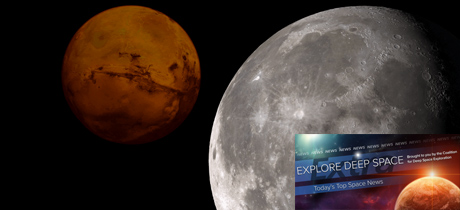In Today’s Deep Space Extra… NASA looks back at its 2018 achievements, from activities aboard the International Space Station (ISS) to the landing of the latest spacecraft on the Martian surface and what they mean for the future. Saturn’s rings appear to be slowly disappearing. Tuesday’s agenda includes four spacecraft launches, three of them in the U.S.
Human Space Exploration
NASA begins America’s new Moon to Mars exploration approach in 2018
NASA (12/17): NASA offers a look back at the agency’s 2018 milestones and how many are helping to chart a course for future human deep space exploration, first with a sustained return to the lunar environment and then to Mars.
Space Science
Saturn with no rings? It could happen, and sooner than astronomers expected
New York Times (12/17): NASA’s now complete Cassini mission to Saturn reveals the famous ring system could be gone within 100 million years. It now appears Saturn’s rings appeared after the planet’s formation.
When the search for asteroids is under the weather
The Space Review (12/17): NASA is pursuing a congressionally established goal of identifying 90 percent of the near Earth objects at least 140 meters in diameter by 2020. Terrestrial weather conditions, however, have made the pursuit difficult, especially for key observatories in Hawaii, and some astronomers are calling for a new space based telescope equipped for the search.
‘Farout!’ Newfound object is the farthest solar system body ever spotted
Space.com (12/17): A distant object dubbed “Farout” appears to be the most distant object yet spotted in the solar system. Estimated at about 500 meters across and 120 times as far from the sun as the Earth, Farout was discovered and observed using powerful ground based telescopes.
Other News
The Moon’s far side and China’s space strategy
The Space Review (12/17): Launched December 6, China’s Chang-e-4 spacecraft was designed to be the first to land on the Moon’s far side. The landing is anticipated for early January, and it may be a further sign that China’s incremental approach to developing space technologies, including a lunar research base, could be far reaching.
AP explains: What happens in a partial government shutdown
Associated Press via New York Times (12/17): NASA employees are among thousands of federal workers facing a furlough if the Congress and White House are unable to find a consensus before the current budget continuing resolution expires on Friday at midnight. Essential functions would continue. Furloughed workers, eventually, would be compensated.
Another day, another launch or make that three, just in the U.S.
Spacepolicyonline.com (12/18): Tuesday marks an unusually busy day for global suborbital as well as orbital launch services. Three launches are scheduled to unfold in the U.S. for Blue Origin, SpaceX and United Launch Alliance (ULA) and one in French Guiana for the European version of Russia’s Soyuz rocket. No passengers. Payloads include the first in a new generation of U.S. global positioning satellites, national security spacecraft and small technology demonstrations.
Pentagon procurement chief Ellen Lord: DOD needs launch vehicles for small satellites
SpaceNews.com (12/17): Ellen Lord, the U.S. Department of Defense (DOD) undersecretary for Acquisition, foresees a need for space launch services capable of launching small satellites on short notice. Lord offered the assessment while speaking with news reporters at the Pentagon on Monday.

